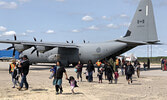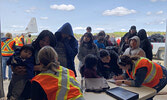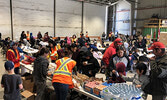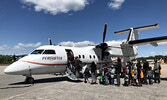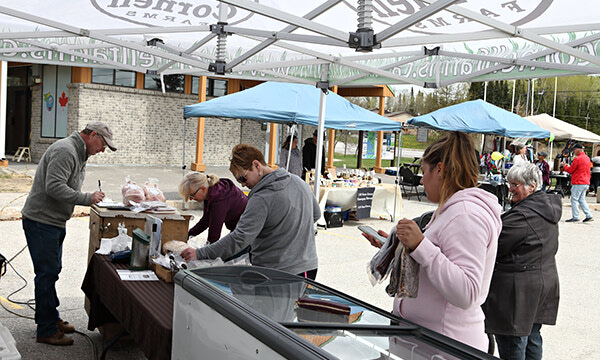Sioux Lookout acts as “hub”, “host” to support Pikangikum evacuees
Tim Brody - Editor
As evacuees from Pikangikum First Nation have fled their community due to its proximity to a wildfire, Sioux Lookout has stepped up to provide as much assistance as possible.
A State of Emergency was declared in Pikangikum on May 29 by Chief Amanda Sainnawap and Council.
Sioux Lookout Mayor Doug Lawrance declared a State of Emergency in Sioux Lookout at 7:00 p.m. on May 30 to ensure the community was well-equipped to assist with the evacuation of Pikangikum First Nation residents.
Sioux Lookout served as a transportation “hub” for Pikangikum evacuees from May 31 to June 1.
Evacuees from Pikangikum First Nation began arriving in Sioux Lookout at approximately 11 a.m. on May 31 via Royal Canadian Air Force C-130 aircraft (“Hercules”).
The Bulletin was told each “Hercules” aircraft flight into Sioux Lookout could contain between 80 and 100 passengers.
Evacuees were welcomed at the Nishnawbe-Aski Police Service (NAPS) hanger at the Sioux Lookout Airport where they were provided with blankets, refreshments, sandwiches, and fruit.
Over the course of the two days, Pikangikum residents arrived via C-130 aircraft and were then transferred onto Dash-7 and Dash-8 aircrafts (arranged by the Ministry of Natural Resources and Forestry) carrying them to host communities where they will be accommodated during the evacuation.
As of 2 p.m. June 2, Cochrane was hosting 245 evacuees, Thunder Bay was hosting 252 evacuees, Smooth Rock Falls was hosting 125 evacuees, Kapuskasing was hosting 736 evacuees and Timmins was hosting 200 evacuees.
Pikangikum First Nation residents The Bulletin spoke with at the NAPS hanger described the experience of the fire being so close to their community and having to be evacuated as “scary.”
Marlene Quill passed through Sioux Lookout on May 31 with her children.
“Yesterday (May 30) the whole reserve was all smoky and you could see little ashes falling,” she shared.
She commented of the wildfire being so close to her community and having to be evacuated, “It’s been overwhelming and scary, scared for my kids.”
She said it was a relief to arrive in Sioux Lookout with her family.
Vince Turtle also passed through Sioux Lookout on May 31 with his daughter.
His girlfriend flew out of Pikangikum with his son the previous day.
He said the whole experience has been “scary.”
Turtle said the fire could be seen from Pikangikum. He believes it started in the garbage dump near the community.
Both Quill and Turtle said they wished they could have been evacuated sooner.
Nadine Strang passed through Sioux Lookout on June 1 with her infant son.
She said she was happy to leave the fire behind.
She said the community had become smoky and said the fire was visible from the community at night.
“I was so scared, scared for my baby,” she said.
Asked about her reception in Sioux Lookout, she said, “Everyone’s nice.”
Tristan Suggashie also passed through Sioux Lookout on June 1.
He too said the fire was visible from the community during the evening.
He said it was “scary” to see the fire that close to the community of approximately 3800 people.
Evacuation efforts in Sioux Lookout were spearheaded by the Sioux Lookout Emergency Control Group, comprised of representatives from the Municipality, Emergency and Police Services, local, provincial and federal health, safety and emergency management agencies and organizations, the Ministry of Natural Resources and Forestry, a variety of First Nations organizations, and community volunteers.
According to a press release issued by The Municipality of Sioux Lookout on May 30, Sioux Lookout’s Emergency Declaration ensured that, “Resources are made available and any costs incurred by the Municipality resulting from the assistance provided, are covered by the provincial and/or federal governments.”
Eight flights, assigned by the MNRF, carried 343 Pikangikum residents out of Sioux Lookout on May 31.
Sioux Lookout hosted 73 evacuees that evening, 39 from flight layover, and 34 who had self-evacuated.
Pikangikum evacuees continued to arrive and depart from Sioux Lookout throughout the day on June 1 as well.
Nine flights, assigned by the MNRF, carried 332 Pikangikum residents out of Sioux Lookout on June 1.
John Coulombe, his wife Cherie and several other volunteers from the community were at the NAPS hanger on June 1 to help make evacuees comfortable.
“We heard there was a need for volunteers to help out and so we wanted to do what we could for the folks that are coming out of Pikangikum,” Coulombe said.
Brian P. MacKinnon, Public Information Officer, Sioux Lookout Emergency Control Group, explained on June 2, that The Office of the Ontario Fire Marshall and Emergency Management (OFMEM) Provincial Emergency Operations Centre (PEOC) – the provincial coordinating entity – determined that Sioux Lookout was no longer required as a ‘hub’ community, and requested Sioux Lookout transition to a host community.
He said all C130 flights out of Pikangikum on June 2 were bound for Winnipeg.
MacKinnon further summarized on June 2, “Sioux Lookout welcomed a chartered flight of a 12-member family who needed to be in Sioux Lookout due to a serious family illness. Sioux Lookout is also in the process of welcoming 46 self-evacuated Pikangikum residents who had been in Kenora for the last couple of days. In cooperation with the Independent First Nations Alliance (INFA) Emergency Operations Centre (EOC) arrangements to have these evacuees make their way to Sioux Lookout is currently underway. We anticipate that these evacuees will be staying in Sioux Lookout for the duration of the evacuation. By nightfall this evening, we will have a total of 80 evacuees in Sioux Lookout.”
MacKinnon clarified, “Looking ahead to tomorrow, June 3rd, in cooperation with IFNA’s EOC, we are working to move self-evacuees who are currently in Dryden to Sioux Lookout. IFNA advises that there are 260 confirmed evacuees in Dryden. These evacuees will be transported (either by their own vehicle or via busses being arranged by IFNA) to Sioux Lookout where they will be housed at either Pelican Falls First Nations High School (PFFNHS), and those evacuees will be taken care of by IFNA; or to a local hotel in Sioux Lookout, and those in Sioux Lookout will be taken care of by the Sioux Lookout Emergency Control Group.” The exact number of evacuees to come to Sioux Lookout from Dryden was still being determined as of the time this article was written.
Nishnawbe Aski Nation (NAN) shared on Facebook on May 31 at 3 p.m., “We have confirmed that the wildfire threatening Pikangikum is directly above the broadband communications line that runs through the community. Pikangikum is now without local phone service and Internet access.
“According to Bell Canada, the following communities still have local phone connections but do not have Internet: Big Trout Lake, Poplar Hill, Deer Lake, Sandy Lake, Angling Lake, Keewaywin, North Spirit Lake, Weagamow, Sachigo Lake, Muskrat Dam and Pikangikum.
“We are working with Bell to determine the extent of any damage to the fibre-optic network and to make any repairs to this infrastructure as quickly as possible. The damaged area is in the middle of the fire and it is unsafe to send technicians. There is concern that if the fire reaches the Central Office it will take longer to get the affected communities up and running.
“Bell is working with the Ministry of Natural Resources Fire Response Crew to secure safe access to the area. The Ontario Provincial Police and the Ministry will inform Bell when it is safe for technicians to access the area for assessment.”
NAN shared on Facebook on June 1 at 8 p.m., “Value protection (sprinkler) efforts also continue at the key infrastructure sites to the south of the fire and within the community.”
NAN shared on Facebook on June 2 at 10 a.m. that reports indicate approximately 1500 people had been evacuated from Pikangikum as of that time.
NAN further shared on Facebook page at 8 p.m. on June 2, “According to the latest Aviation, Forest Fire and Emergency Services (June 2, 17:54), the fire is now 3360.8 hectares in size. The fire is not yet under control. Sixteen FireRanger crews continue to suppress the fire assisted by the firefighting aircraft. Aerial ignition operations were successfully completed yesterday on the southeastern side of the fire. An incident management team will be assigned to the fire early next week.
“Fire Hazard in Northwest Region: The fire hazard in the southwest part of the region (Kenora, Fort Frances, Dryden and a portion of the Red Lake sectors) is high. Conditions in the Thunder Bay, Nipigon and Sioux Lookout range from high in the south and moderate-low in the far north.
“We will provide further updates as the situation unfolds. Please keep Pikangikum in your thoughts & prayers.”


